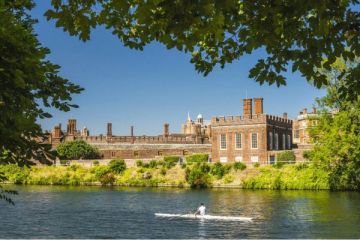Double-decker red buses seem to be synonymous with London, but there are "single-deckers" carrying travellers around the city, too. Single or double, there are a few basic tips to get the most out of bus travel in the London area.
Bus stop signs list the route numbers of the buses that stop there. If a bus is listed as "Request Only", then you must flag down the bus by raising your arm. If you don't, they won't stop.
Nowadays the old Routemaster double-deckers are being phased out in favour of modern replacements. So what? Well, there is a reason to care if you're a tourist. On the old buses, you could simply hop on, find a seat, and wait for the conductor to come around to pay your fare. On the modern buses you pay the driver as you board, and you must have the exact change. Unless, of course, you have a ...
Bus Pass
There are weekly and monthly passes good for unlimited travel on all London buses, but a better deal is the London Travelcard, good for unlimited travel on both the Underground and the buses. Travelcards can be purchased for 7 days or more at a time, but they require a passport-sized photo.
Visitorcards are another option. They do not require a photo, and can only be purchased outside the UK. In addition to unlimited bus and Underground travel, they include discount vouchers for many popular tourist attractions. Note that the Visitorcard is NOT valid for the Heathrow Express.
If you live in the US, London Visitorcards are available for AAA members from AAA offices. Save yourself time by getting yours before you go.
Greater London is divided into 6 transit zones. Anytime you travel beyond one zone the fare rises. You can save money by only buying as far-ranging a Travelcard as you'll need, but do not try to use a pass to go to a zone you are not authorized for! You'll be liable for a fine, and inspectors DO check.
Take a good look at the zones on a transport map (available free at any tube station or at the London Transport web site). Most of the major tourist attractions are located in Zone 1, so you're fairly safe with a Zone 1 or a Zone 1-2 card. However, be sure to check the location of your hotel against the fare zone map. If your hotel is out in zone 6 and you will be travelling to Inner London, you'll need an all-Zone Travelcard.
Travelcards come in a bewildering variety of options. These are sample cards. For up to date prices, visit the London Transport web site.
Weekly Travelcard
Adult Zone 1
Adult Zone 1-6 (ALL-Zone)
Visitorcard
Zone 1- 2
3 day
4 day
7 day
Touring
London buses can provide a good orientation for first-time tourists. Several routes in particular connect popular travel destinations.
East-West
Route 11 begins at Liverpool Street Station and passes St. Paul's before traveling along Fleet Street and The Strand to Trafalgar Square. Then it swings through Westminster and posh Sloane Square before taking in King's Road.
Route 14 starts in Riverside-Pulteney, before traversing Fulham Road, South Kensington, Knightsbridge, Hyde Park, Piccadilly Circus, Leicester Square, and Soho.
North-South
Route 24 begins at Hampstead Heath and travels through Camden and Tottenham Court Road to Charing Cross Road, Leicester Square, and Trafalgar Square. From there it goes through Whitehall, past Westminster Abbey to Victoria Station and on to Pimlico.
Night Buses
London Transport has wisely introduced night buses (marked with an 'N' on bus signs), which cover the late night time period when there is no underground service. Night buses begin service about 11:30 and run until about 6AM.



